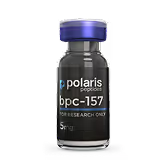Orexin-A
Orexin-A is a 33–amino-acid messenger in the brain that tells your body to wake up and stay alert. It works by turning on specific receptors that promote arousal, energy use, and appetite balance. In research, delivering Orexin-A has helped reduce extreme sleepiness and improved focus, pointing to potential treatments for sleep disorders like narcolepsy and fatigue-related conditions.
Compound Overview
About the product
The peptide shares a conserved core sequence of 33 amino acids, including two disulfide bonds that stabilize its helical structure. It contains only natural L-amino acids with no further chemical modifications in its native form. Research-grade Orexin-A is synthesized by solid-phase peptide synthesis and purified to ≥95 % by HPLC. Mass spectrometry confirms its correct molecular weight and disulfide connectivity.
Orexin-A binds to two G-protein-coupled receptors, OX₁R and OX₂R, located throughout the brain, especially in arousal-related regions. Activation of these receptors promotes neuronal firing and release of excitatory neurotransmitters like glutamate and monoamines. This signaling sustains wakefulness, prevents inappropriate transitions into REM sleep, and modulates reward pathways. Downstream effects include increased alertness, feeding behavior, and energy expenditure.
The peptide is studied for its potential to treat sleep disorders and metabolic dysregulation. In early human research, intranasal or intravenous Orexin-A administration increased wakefulness in models of sleepiness. Animal models suggest benefits in disorders of excessive daytime sleepiness and obesity by enhancing arousal and energy use. Ongoing trials are exploring its therapeutic value in narcolepsy, idiopathic hypersomnia, and metabolic syndrome.
Short-term human studies report mild headache, transient increases in blood pressure, and local irritation with intranasal delivery. No serious adverse events have been noted in trials up to several days. Long-term safety data are lacking, particularly regarding chronic central nervous system exposure. Monitoring cardiovascular and neurological parameters is recommended in research protocols.
Orexin-A is synthesized by Fmoc solid-phase peptide synthesis on a resin support, including on-resin formation of its two disulfide bridges. After cleavage and deprotection, it is purified by preparative HPLC to research-grade purity. Analytical HPLC and mass spectrometry verify sequence, purity, and correct disulfide pairing. Manufacturing follows peptide-compounding standards under good laboratory practice.
Orexin-A is classified for investigational use only and is not approved by the FDA, EMA, or other major regulatory agencies. It is available to research institutions under investigational-new-drug or equivalent frameworks. No prescription or over-the-counter formulations exist. Clinical use outside of sanctioned trials is prohibited.
Human studies have tested intranasal doses of 1–10 mg and intravenous infusions of 1–3 µg/kg, administered acutely before sleepiness assessment. Dosing regimens vary by delivery route and study objectives. No standardized dosing guidelines exist outside approved protocols. All administration must follow ethical and safety monitoring requirements.
- Do conduct use only within IRB-approved sleep or metabolic-disorder trials.
- Do monitor blood pressure, heart rate, and alertness levels during administration.
- Don’t use as a substitute for established narcolepsy or insomnia treatments outside research.
- Don’t combine with stimulants or sedatives off-protocol.
- Q: Can Orexin-A permanently cure narcolepsy?
- A: No; it may transiently improve wakefulness but does not restore lost neurons.
- Q: Does it affect appetite?
- A: It can increase feeding behavior in preclinical models, but human effects are under study.
- Q: Is it safe for long-term use?
- A: Long-term safety has not been established; current data cover only short-term administration.
For research use only. Not approved for medical use.


